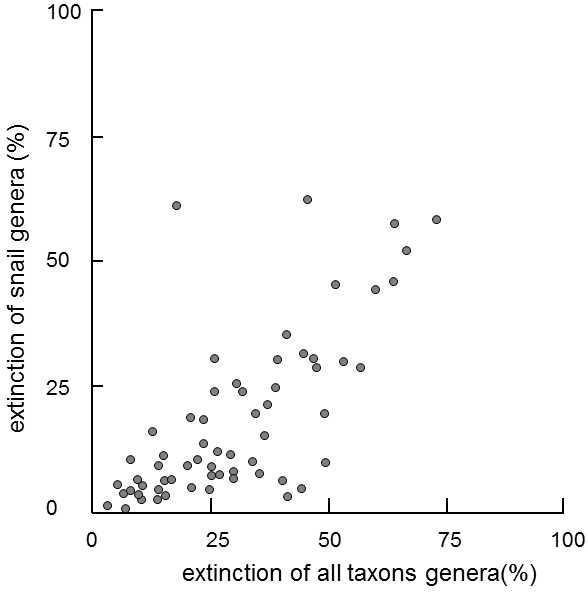XXII.5.4 Mass extinctions tend to affect a broad range of ecosystems and a broad range of species within them, but the ecological and taxonomic specificity varies from case to case
The individual periods of mass extinction also differ in their degree of specificity, i.e. range of species that are primarily affected.Taxonomic specificityis generally rather low.The members of various developmental lines that live in a similar environment and have similar ecological requirements tend to be affected to the same degree (Raup 1994)(Fig. XXII.7).

Fig. XXII.7 Low taxonomic selectivity of extinction. The graph documents the high correlation between the intensity of extinction of snail genera and the intensity of extinction of other genera of aquatic fauna. This highly significant correlation indicates that the individual genera of fauna were mostly affected by extinction independently of their taxonomic classification. Each point on the graph corresponds to one chronostratigraphic stage of the Phanerozoic. Modified according to Raup and Boyajian (1988a).
Nonetheless, it seems that, at least in some cases, a certain taxonomic specificity is manifested. For example, mass extinction at the boundary between the Mesozoic and Tertiary affected mainly dinosaurs on the continents, while mammals crossed this boundary with substantially smaller losses.A study performed on 117 North American genera of mammals, reptiles, amphibians and fish demonstrated that 43% of genera became extinct at the end of the Cretaceous.Simultaneously, however, all 22 genera of dinosaurs became extinct, while only 8 of 24 genera of mammals died out.Similarly, only 4 of 12 genera of amphibians became extinct (Raup 1994).
Ecological specificityis usually somewhat greater.Certain communities of organisms were especially affected during some periods of mass extinction, for example communities of marine or, on the other hand, terrestrial ecosystems (Benton 1995).In some cases, on the basis of affecting of the individual types of organisms, it was possible to estimate what was the immediate cause of extinction of organisms in a particular period.
